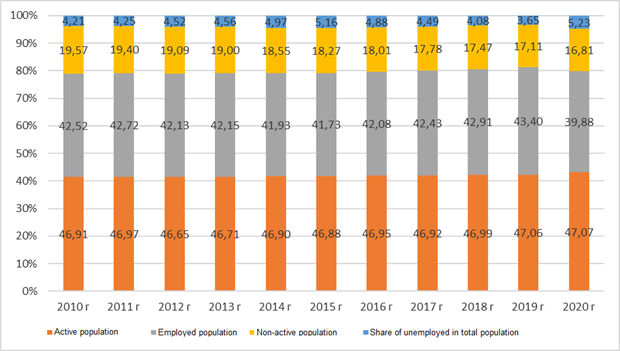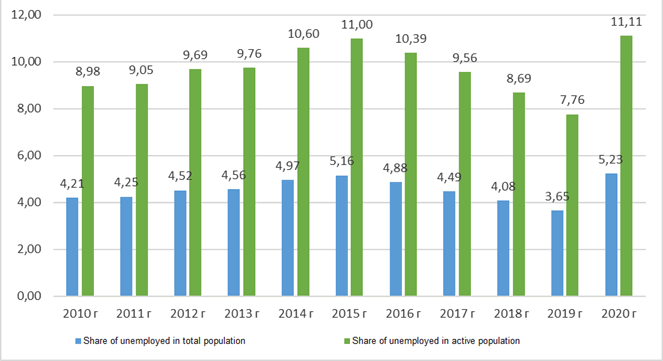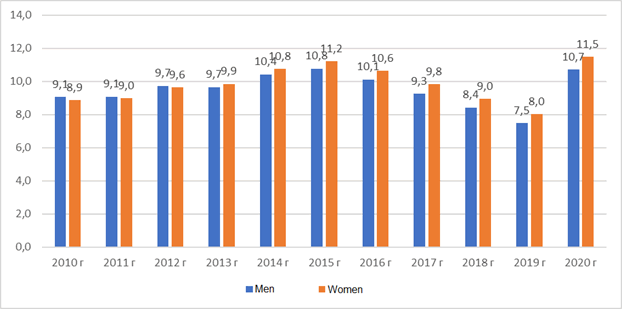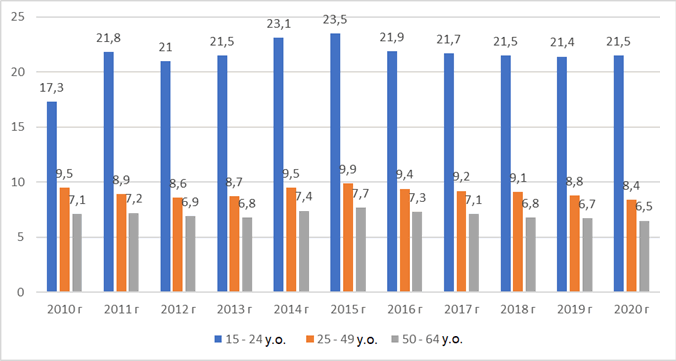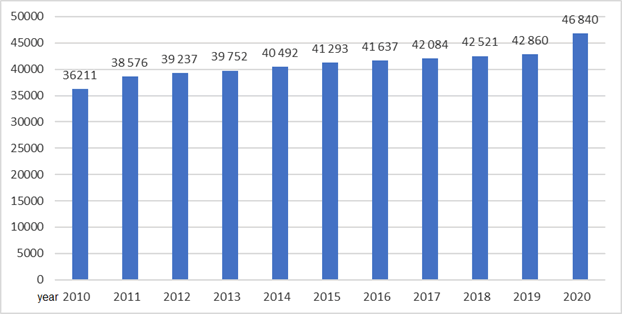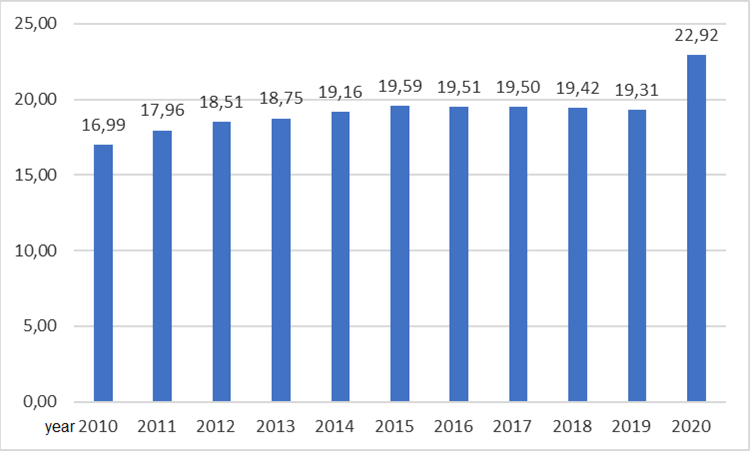Research Article: 2021 Vol: 24 Issue: 6S
Regulation of the Labor Market of the European Union in the Context of the Digitalization of the Economy
Elena Rostislavovna Schislyaeva, Saint Petersburg State Marine Technical University
Olga Anatolievna Saychenko, Saint Petersburg State Marine Technical University
Keywords
Labor Market, Employment, Digitalization, Precarious Work, NEET
Abstract
The study aims to systematize the experience of the European Union in regulating the labor market against the background of the ubiquitous spread of digital technologies in the global economy. The purpose of the study is to analyze modern practices of labor market regulation across the European Union and the directions of their transformation under the influence of digitalization of the economy. As a result of the study, it was revealed that the European labor market in the last decade has been undergoing changes under the influence of the digitalization of the economy: the sectoral structure of employment is changing, the scale of part-time employment and distance employment is growing. Accordingly, current trends in supranational labor market regulation on the scale of the European Union are aimed at adapting regulatory practices to new forms of employment, as well as at developing human potential in the context of developing competencies among workers that will be in demand in the future.
Introduc tion
In modern conditions, the methods used by the national and macroregional governments to revive the economy, contributing to overcoming the crisis, ways to increase the efficiency of existing production are associated, first of all, with reproduction of the labor force and increase in the level of employment of the population. This is true both for the European Union as a whole and for individual states that are members of the Union, their constituent regions, as well as individual intraregional municipal territories.
The unbalance between the parameters of the existing demand for labor on the part of employers and the existing offer on the part of workers is currently characteristic of all countries where a problem of low employment levels of the working-age population is evidenced. An additional influence on the level of employment of the population is exerted by the trends of digitalization of the economy: with introduction of digital technologies into various industries and spheres of activity, the structure of demand for labor in the context of professions is undergoing a change, the requirements of employers to workers are also changing, and some job positions are being substituted by mechanisms.
The problems of labor market regulation in the context of the digital transformation of the economy, as well as the experience of different countries and regions, are considered by many domestic and foreign researchers.
In particular, Boulware K. and Kuttner K. consider the impact of digitalization trends in the global economy on the world labor market, highlighting the digital labor market emerging in modern conditions and its differences from the traditional labor market (Boulware & Kuttner, 2019).
Deschenes O. explores the implications of the digital transformation of the global economy in the context of employment management by the state and the supranational institutions (Deschenes, 2018).
The attention of many foreign researchers is attracted by such a negative labor market phenomenon as the ubiquitous spread of the NEETs (Not in education, employment or training) category among the population of the European Union. Bingöl & Ayhan (2020) investigates the nature of this phenomenon and the possibilities for development of the human potential in the countries of the European Union (Caroleo, Rocca, Mazzocchi & Quintano, 2020). Being NEET in Europe Before and After the Economic Crisis: An Analysis of the Micro and Macro Determinants (Caroleo, 2020) investigate macro- and micro-trends in the spread of NEETs in the European Union in connection with the economic crises.
The Covid-19 pandemic has made an impact on the labor market, which has been forced to rapidly adapt to new conditions. Handwerker, Meyer, Piacentini, Schultz & Sveikauskas (2020); Mayhew & Anand (2020) investigate the impact of the Covid-19 pandemic on the European labor market and the UK labor market.
Methodology and Scientific Research
One of the goals of creating the European community is to ensure maximum employment of the working-age population, which was already mentioned in the Treaty of Rome. In the early years of formation of the European Union, it was believed that stimulation of the European economic growth should be used as the key direction for solving the existing problem of unemployment. However, subsequently the paradigm of employment has changed, and today the creation of new high-quality and efficient job positions by specialists is perceived as a tool that helps to increase the declining pace of European economic development.
The main EU Treaty implies a high level of employment, labor integration and development of the social sphere as the main aspects of development of the common European labor market. At the same time, the function of direct regulation of national labor markets is entrusted to national governments.
Analysis of the State of the EU Labor Market in the Period from 2010 to 2020
Figure 1 illustrates the structure of the EU population according to the labor status Despite the growth in the active population of the EU, its share in the population structure remains practically unchanged, only minor fluctuations are observed.
Figure 1: The Structure of The EU Population According to the Labor Status, %
Source: drawn up by the data https://ec.europa.eu/eurostat
The share of the employed population in the structure of the EU population in 2010-2015 decreased slightly from 42.72% to 41.73%. Starting from 2016, the share of the employed population in the structure of the EU population increased to 43.79% in 2018. However, in 2020, the share of the employed population decreased sharply to 39.83%.
There is a consistent and stable decrease in the share of the economically inactive population in the structure of the EU population: from 19.57% in 2010 to 16.81% in 2020. The share of the unemployed in the structure of the EU population increased from 2010 to 2020. The peak unemployment rate in 2015 is 5.16%. After that, the unemployment rate steadily decreased to 3.65% in 2019. However, in 2020, the unemployment rate increased to 5.23%.
Figure 2 illustrates the dynamics of the share of the unemployed in the total population and in the active population.
Figure 2: Dynamics of the Share of the Unemployed, %
Source: drawn up by the data https://ec.europa.eu/eurostat
In general, the dynamics of unemployment in the structure of the total population and the active population is characterized by similar trends: the unemployment rate increases until 2015, after which it gradually decreases, up to growth in 2020. At the same time, the share of the unemployed in the structure of the active population changes more sharply.
Half of all employed people in the EU are employed in enterprises having a staff of fewer than 50 people. Microenterprises (employing up to nine workers) account for 93% of all enterprises, 30% of the total employment and 21% of the added value. Large enterprises (with more than 250 employees) employ 33% of the labor force and produce 43% of the total added value (Deschenes, 2018). Therefore, the enterprises that create job positions are characterized by significant polarization: mostly they are small enterprises; at the same time, productivity reaches its maximum mainly in large enterprises.
Let’s investigate the gender and age characteristics of employment in the European Union. Figure 3 illustrates the dynamics of the share of unemployed men and women.
Figure 3: The Dynamics of the Share of Unemployed Among Men and Women, %
Source: drawn up by the data https://ec.europa.eu/eurostat
The dynamics of change in the share of unemployed among men and women is comparable: the peak unemployment rate falls on 2015. At the same time, since 2013, the share of unemployed among women tends to exceed the share of unemployed among men. So, for example, in 2010, there were 9.1% of unemployed among men, while there were 8.9% of unemployed among women. In 2011, there were 9.1% of unemployed among men, while there were 9.0% of unemployed among women. In 2012, there were 9.7 % of unemployed among men, while there were 9.6% of unemployed among women. In 2015, the share of unemployed among women exceeded the share of unemployed among men for the first time, amounting to 9.9% compared to 9.7%. Later on, the difference in the share of unemployed among men and women increases: in 2020, there are 10.7% of unemployed among men, and 11.5% among women.
Figure 4 illustrates the dynamics of the share of unemployed in different age groups.
Figure 4: The Dynamics of the Share of Unemployed in Different Age Groups, %
Source: drawn up by the data https://ec.europa.eu/eurostat
The maximum unemployment rate is observed in the age group of 15-24 years old: since 2011, the unemployment rate in this age group has never dropped below 21%. The highest unemployment rate among youth was observed in 2015, when it amounted to 23.5%.
The unemployment rate in the age group of 25-49 years old is comparable to the all-European level and changes consistently with the all-European dynamics.
In the age group of 50-64 years old, the unemployment rate is the lowest compared to other age groups. This is due to the fact that representatives of this age group shift to the group of the economically inactive population more often.
During the period under investigation, the structure of the EU labor force has been changing. The number of employed women and the number of employees of the elderly age has increased, while the number of young employees has decreased to a lesser extent. The decrease in youth employment can be explained, firstly, by the high rate of general unemployment in the European Union, and secondly, by more extensive participation of young people in educational activities compared to other age groups, which often serves as a real alternative to participation in labor activities for the European youth. The increasing level of participation of elderly employees in the labor activities in recent years is a natural consequence of changes in adjustment of the retirement age over the past decade, also this is the result of development of more flexible types and forms of organization of labor activity for elderly employees.
Figure 5 illustrates the population in part-time or temporary employment.
Figure 5: Partly Employed Population of The EU, Thousand People
Source: drawn up by the data https://ec.europa.eu/eurostat
It should be noted that in the EU-28 during the investigated period the share of employees who consider part-time employment as their main form of employment increased from 16.99% in 2010 to 22.92% in 2020. The coronavirus pandemic became an important factor in the spread of part-time employment in 2020, when the labor market was forced to rapidly adapt to legal restrictions and bans on exercise of occupation.
Figure 6 illustrates the share of the part-time employed EU population in the total employed population.
Figure 6: The Share of the Part-Time Employed Population in the Total Employed Population, %
Source: drawn up by the data https://ec.europa.eu/eurostat
On average, one in five workers is currently employed part-time. Every third woman and every tenth man works in such conditions. Part-time employment is expanding most notably among young employees (aged 15-24) and among men.
Problems of the EU Labor Market
According to the European Financial Stability Facility, under the European Union conditions it is possible to distinguish a limited number of such occupations that accumulate significant (in absolute terms) subpopulations of workers. On average, across the European Union, only 11 occupational and industrial groups of employees concentrate 25% of the total employed population, 50% of the employed population of the European Union works in a range of 60 occupations accumulating job positions. Among the largest of these occupational groups are retail workers (their number reached 12 million in 2019) and teachers in the field of secondary and higher education (their number reached 9.6 million in 2019) (EU Network of Public Employment Services Strategy, 2020). While the above 11 occupational-sectorial groups have been characterized by a stable level of employment over the past five years, in the remaining occupational-sectorial groups the number of job positions is decreasing.
In particular, the largest losses in the number of job positions in recent years have been observed in such industries as residential and commercial construction, heavy and light engineering, food processing, electricity and the banking sector. It should be noted that in these industries the maximum growth in the level of automation of business processes is observed.
Increases in the number of job positions have been observed in the service sector, this applies to both grassroots positions, i.e., service personnel, and highly qualified employees such as doctors of various specializations. In addition, the number of job positions increased in areas such as information and communication technologies (10% increases in 5 years) and business administration (9.2% increase in five years).
In 2019, the number of such a category of workers as self-employed (self-employed is a form of receiving remuneration for work directly from customers, as opposed to hired work) amounted to 35.8 million people, that is, 14.6% of the total employed population of the European Union. Among the self-employed, 28.6 million workers were working full-time, and 7.1 million workers were working a shorter working day or week. The share of women among self-employed workers in 2019 was slightly more than a third - 34.2%.
The spread of underemployment in the EU today can be regarded as a problem. The increase in the number of part-time workers mainly occurs not by their personal choice, but under the pressure of various economic circumstances like the inability to find a full-time job, the need to combine work with study (Asali & Gurashvili, 2020). The part-time employment of the European Union population is quite unevenly distributed among different economy sectors and different qualification categories of employees.
In 2019, in the EU-28, the greatest prevalence of part-time employment was observed among unskilled and low-paid job positions. Among part-time employed women, 54% worked on such job positions; among part-time employed men, the share of workers employed on unskilled and low-paid job positions was 22%. There is also a significant spread of part-time employment of the population in trade (40% of part-time workers) and in the service sector (17% of part-time workers) (Handwerker et al., 2020).
In addition, we should note such a problem as the “underemployment” of the population of the European Union, “underutilization” of the available labor force. The development of this trend leads to an increasingly large-scale distribution of the “NEETs” category (Not in education, employment or training - NEETs, Not-in-Labor-Force - NiLF) among the population of the European Union. This category is one of the constituents of the able-bodied but not economically active population of the European Union. While earlier this category mainly included a part of the European Union population that was not employed for objective reasons (retired people who have finished their labor activity, disabled people, students who haven’t started their labor activity), in recent years the category of inactive population is more and more often replenished by people of working age who have enough physical opportunities to work but do not seek to work or to get education.
The concept of “NEETs”, according to some data, came into scientific use in the United Kingdom in 1999, and thereafter it quickly became widespread. The share of “NEETs” among the working-age population of the European Union was 13.2% as of 2012. Subsequently, the share of “NEETs” among the population of the European Union decreased to 12% in 2019. This population category of includes two groups:
• First, the passive core, the number of which has not undergone any significant quantitative changes in recent years;
• Second, a temporary part of the group, a situational part, which is ready to continue both education and work in the future if favorable conditions arise.
The permanent core of the “NEETs” category is present among the population of all countries that are members of the European Union, while its share among the population of different countries is different: in the Netherlands there are 3% of “NEETs” among the working-age population, in Romania and Italy there are 12% of “NEETs” among the working-age population, in Bulgaria there are 14.3% of “NEETs” among the working-age population (Caroleo et al., 2020).
The “NEETs” category is replenished with new citizens who do not want to work and receive education at various stages of socialization as well as from various sources. So, for example, “NEETs” includes children from disadvantaged families and residents of depressed regions of the European Union. Among the reasons for entering the “NEETs” category, the following can be distinguished: adolescents from disadvantaged families leave school prematurely, failures in initial career choice, failures in the process of receiving higher education, failures in the process of finding a job, deliberate opposition to the formal lifestyle of the society.
Results of The Study
Two factors are of particular importance for provision of employment: first, the currently persisting sluggish rates of economic growth in the European Union; second, the rapid technological changes.
As of today, a weak growth of the European Union economy is predicted, and accordingly, no increase in demand for labor from employers is expected. Although employment growth was observed in most countries of the European Union until 2020, many of the job positions created in recent years did not quite fit into the model of the standard traditional labor relationship.
New waves of ongoing technological changes in the long term lead to higher levels of productivity and inspire economic growth. However, these changes are often viewed as a factor weakening the capability of the European economy to create new job positions.
The nature of the impact of new information technologies on the economy is complex and quite extensive, and the consequences of technological development on employment are rather ambiguous. On the one hand, technological advances can promote substitution of the traditional human labor. On the other hand, technologies in the future can also complement the totality of the labor resources existing in the economy, and technological development can lead to emergence of new occupations (for example, such as a specialist in SMM promotion).
The experience of countries where technological advances have spread to most of the main sectors of the national economy shows that the existing fears of displacement of workers by technologies have mostly turned out to be unreasoned. New technologies actually coexist with workers, helping to improve their productivity level as well as to optimize working conditions. This is due to the fact that with the help of technology, employees are relieved from performing the most physically demanding tasks. Thus, opportunities open up to increase the employees’ satisfaction with their work activities.
In addition, the spread of technological advances is raising the demand for labor in other sectors of the European economy. One such sector is the care economy. The growing trend towards aging of the population in the European Union necessitates the formalization of care for the elderly people. This opens up prospects for future creation of a large number of new job positions in this sector of the economy.
However, currently it is unclear how the job positions created in this sector of the economy receive financing. The existing social security and protection systems in the European Union are already under significant strain. Moreover, the poverty of a significant part of the elderly population is a problem for many countries of the European Union. One of the ways to finance job positions in the care economy is to increase the amount of individual savings of people. However, other ways also need to be found to ensure monetization and institutionalization of the works rendered in the elderly care.
Other economy sectors where significant growth in labor demand is expected in the future are “green” sectors of the economy, health care, education and additional vocational training, in addition, the leisure industry and the tourism industry are also the sectors generating job positions. The ILO is currently implementing the project “Decent Work in Green Economy”. This project focuses on the aspects of employment in the process of transition to the green economy.
The following problems of operation of the European Union labor market are highlighted. First, the lack of common approaches to regulation of national labor markets in the context of deepening differentiation of the conditions of national economies. Second, the developing polarization and social differentiation between employees: women, migrants, low-skilled workers not only suffer from unemployment more than other groups, but also work in worse conditions and for lower wages. Third, there is a growing tendency for young people not to participate in working and educational activities. Fourth, the migration crisis of 2015-2016 led to a significant increase in the number of migrants and increased the burden on the labor market.
The European Commission, after many public consultations, proposed the creation of such an initiative as the European Component of Social Rights. This component includes 20 key principles and fundamental rights. These principles and rights are divided into the following three categories:
• Equal opportunities and access to the entire labor market for the entire population;
• Provision of all employees with fair working conditions;
• Provision and integration of social protection for all categories of the population.
The process of implementing the above principles will be accompanied in the future by a number of legislative and administrative measures to be taken at the national and EU levels, as well as by constant social dialogue, the formation of political recommendations for the governments of the European countries and the provision of financial assistance to the EU countries. In addition, creation of a special “social scoreboard” is envisaged with the help of which the progress in implementation and introduction of a set of established principles will be measured.
An important task in implementation of the state policy in the European region is the development of entrepreneurship. Three categories of the entrepreneurial activity can be identified:
• Provision of local services and implementation of trade operations;
• Innovative enterprises;
• Self-employment of the population.
In the first category, the largest number of traditional job positions circulates by emerging and disappearing. This is due to the fact that small ventures of the entrepreneurial activity appear and disappear en masse, which is determined by such factors as the local economic situation, personal circumstances of business entities, skills and assets of business entities. The second category, i.e., the innovative entrepreneurship, offers broader and diversified opportunities for growth and creation of job positions in the long term. In the third category of the entrepreneurial activity, various features of independent employment and dependent employment are combined; correspondingly, in connection with implementation of the entrepreneurial activity in this category, a number of different legal issues arise.
It is necessary to promptly solve a complex of cumulative problems in the European region associated with a decrease in the current level of professional qualifications of the European labor force. The massive downgrading of qualifications is caused by the high unemployment rate, the inconsistence increasing in recent years between the existing professional skills of employees and the requirements of the modern labor market, the changes in the forms and types of economic activity, as well as the massive aging of the labor force available in the region.
Among the goals of the national policy pursued in different countries of the European region, we can highlight the following: increasing the attractiveness of vocational education and training (hereinafter - VET) for workers; improving the definition of a set of core competencies and necessary skills in national standards and qualifications frameworks; massive creation of opportunities for provision the workers with vocational training in the framework of VET; stable tightening of requirements for organizers of training regarding guarantees of the future quality of training. In a number of European countries, options have expanded for cooperation between different VET providers, national employment services, and organizations of employers and workers. Such cooperation is currently taking a variety of forms. In addition, it can also be used to promote a proactive approach of employees to lifelong learning and training.
The development of technologies and the emergence of various socio-economic innovations contribute to creation of a set of new opportunities for economic growth. However, these opportunities in the future can be effectively implemented only if the level of qualifications of the labor force is sufficiently high. Accordingly, significant efforts will be required to address the following three tasks:
• Iterative professional development of all employees through the implementation of continuous training throughout the entire employee’s life;
• Retraining of persons who are outside the modern labor market to ensure the reintegration of these persons into the labor market;
• Development of new and relevant professional skills among employees for massive creation of labor resources adapted to new conditions, occupations and job positions.
The tendency to dissolution of stable traditional labor legal relations in modern conditions creates a set of new problems on the way of massive enhancement of employees’ competences and professional skills. Traditionally, continuous training of workers has been carried out at enterprises, which in some cases retained most of their personnel throughout the entire employee’s working life. However, in modern conditions, the likelihood of an employee to stay working at the same enterprise throughout his entire working life is small. The increasing spread of various types of temporary work, part-time employment, as well as other forms of flexible organization of labor activity in modern conditions reduce the likelihood of enterprises investing in development of a complex of long-term personnel skills and competencies.
In combination with the growing demand for training employees throughout their working life, this means actually shifting the responsibility for education to an individual employee. Accordingly, we can say that in modern conditions the costs of training and the risks of an employee associated with training are becoming of individual character. At the same time, it is employers who, in the future, risk facing a critical shortage of relevant professional skills and necessary competencies in the available labor force.
Thus, there is a need to strengthen and develop the different formats of partnerships that can arise between traditional types of educational institutions and enterprises. The importance of the joint development of prospective educational plans by educational organizations and enterprises is also increasing, as well as the relevance of practical training of students at enterprises is growing.
Discussion
The authors propose to hold a discussion on the fact that regulation of the modern labor market can now be considered as a kind of ecosystem in which a set of different institutions and a complex of different processes exist in a stable state of symbiosis. The considered issue could be investigated from the different aspects of the digital transformation. Some interesting points of view regarding both the sharing economy and digital retail as well as digital twin implementation in various fields are described in works (Barykin et al., 2021; Barykin et al., 2021). Authors suppose that the impact of different fields of digital transformation of economy including the digitalization of labor market could be considered as suggestions for scientific discussion. It can be shown that many decisions on regulation of the labor market will have financial consequences in the long term that will affect the ability of governments to provide labor market participants with the necessary social protection, as well as to form a massive labor force that can effectively adapt to constantly changing economic conditions and social needs in the future. In addition, tax systems in modern conditions need to ensure that each participant of the labor market makes their fair contribution to financing the national and supranational labor market management system and mechanisms for protecting the rights of employees. Thus, we can conclude that improving the operation of the European Union labor market implies the implementation of measures in the following areas: development of the entrepreneurship and creation of new job positions, training and retraining of employees in accordance with the requirements of the digital economy, development of the labor market regulation in the context of economic transformation.
Conclusion
Cyclical changes in the economy led to a significant increase of unemployment in the European Union, that peaked in 2013. From then on, we observe a slow recovery of the European labor market, however, there is a number of problems with its functioning, including those caused by COVID-19. Under the conditions of differentiation of national economies, it is difficult to form common approaches to the regulation of the European labor market.
Besides, there is an increase in social differentiation and polarization of employees by gender, education level and country of origin. The tendency of non-participation of young people in education and working activities is developing, which is manifested by the large-scale spread of the “NEETs” (Not in education, employment or training) category. In addition, the European labor market was under significant pressure from the migration crisis of 2015-2016. In modern conditions, it is necessary to create such mechanisms for regulating the labor market that are capable of ensuring the effective exercise of fundamental labor rights and principles within the entire space of the modern labor market. In addition to the developing trends of globalization and digitalization of the economy, in the near future, the coronavirus epidemic will significantly affect the economy and labor market of the European Union. A significant increase in unemployment is expected, an even greater spread of part-time employment and self-employment, and activation of the digital labor market segment.
In the future, the recovery growth of the economy will lead to an increase in employment. At the same time, in the context of development of digitalization of the economy, employees in such areas as science, technology, engineering and mathematics will be especially in high demand. Moreover, professional activities will increasingly require a combination of technical skills and IT competencies. Also, in the long term, growth of employment in “green” industries is expected.
In the process of managing the labor market, it is necessary to pay special attention to the following elements of this management ecosystem of regulation.
The first element is the legislative framework, which regulates the totality of relations between many different participants of the modern labor market, as well as their respective rights and existing responsibilities.
The second key element is the social dialogue, which today plays a decisive and fundamental role in determining the parameters of the legislative framework that is relevant for a specific moment in time, and also provides the participants of the real economy with the opportunity that their voices will be heard in the process of formation of the legislative framework.
The third element is the labor market regulation system. This system ensures application of the fundamentals of the labor legislation in practice, promotion of employment of the population and coverage of all employees with the existing social protection systems, as well as the possibility for employees to exercise their labor rights. A number of closely interrelated organizations and institutions operate within the framework of this system in order to perform the complex of these functions. This system includes labor inspection bodies, employment services and information systems operating in the labor market.
The following directions for improving the operation of the European Union labor market are highlighted: development of the entrepreneurship and creation of new job positions, training and retraining of employees in accordance with the requirements of the digital economy, development of the labor market regulation in the context of economic transformation.
References
- Asali, M., & Gurashvili, R. (2020). Labour market discrimination and the macroeconomy. Economics of Transition and Institutional Change, 28. DOI: 10.1111/ecot.12249.
- Barykin, S.Y., Kalinina, O.V., Kapustina, I.V., Dubolazov, V.A., Esquivel, C.A.N., Nazarova, E.A., & Sharapaev, P.A. (2021). The sharing economy and digital logistics in retail chains: Opportunities and threats. Academy of Strategic Management Journal, 20, 1–14.
- Barykin, S.Y., Kapustina, I.V., Sergeev, S.M., Kalinina, O.V., Vilken, V.V., Putikhin, Y.Y., & Volkova, L.V. (2021). Developing the physical distribution digital twin model within the trade network. Academy of Strategic Management Journal, 20, 1–24.
- Barykin, S.Y., Bochkarev, A.A., Dobronravin, E., & Sergeev, S.M. (2021). The place and role of digital twin in supply chain management. Academy of Strategic Management Journal, 20, 1–19.
- Barykin, S.Y., Bakharev, V.V., Mottaeva, A.B., Aminov, K.I., & Ikramov, R.A. (2021). Features of a combined approach to corporate innovative strategic planning. Academy of Strategic Management Journal, 20, 1–10.
- Barykin, S.Y., Smirnova, E.A., Sharapaev, P.A., & Mottaeva, A.B. (2021). Development of the Kazakhstan digital retail chains within the EAEU E-commerce. Academy of Strategic Management Journal, 20, 1–18.
- Barykin, S.Y., Kapustina, I.V., Valebnikova, O.A., Valebnikova, N.V., Kalinina, O.V., Sergeev, S.M., … & Volkova, L.V. (2021). Digital technologies for personnel management: Implications for open innovations. Academy of Strategic Management Journal, 20, 1–14.
- Boulware, K., & Kuttner K. (2019). Labor market conditions and discrimination: Is there a link? AEA Papers and Proceedings, 109. 166-170. DOI: 10.1257/pandp.20191086.
- Bingöl, U., & Ayhan, F. (2020). The impact of NEET and labor market indicators on human development: A panel data analysis for EU-28 countries, 443-470. DOI: 10.26650/jspc.2020.79.0158.
- Caroleo, F., Rocca, A., Mazzocchi, P., & Quintano, C. (2020). Being NEET in Europe before and after the economic crisis: An analysis of the micro and macro determinants. Social Indicators Research, 149, 1-34. DOI: 10.1007/s11205-020-02270-6.
- Deschenes, O. (2018). Environmental regulations and labor markets. IZA World of Labor. DOI: 10.15185/izawol.22.v2.
- EU Network of Public Employment Services Strategy to 2020 and beyond: http://ec.europa.eu/social/BlobServlet?docId=9690&langId=en
- European Commission – Statement. Fair labour mobility: Commission welcomes agreement on the European Labour Authority: http://europa.eu/rapid/press-release_STATEMENT-19-844_en.htm
- Eurostat: https://ec.europa.eu/eurostat
- Handwerker E., Meyer P., Piacentini J., Schultz M., & Veikauskas L. (2020). Employment recovery in the wake of the COVID-19 pandemic. Monthly Labor Review. 2020. DOI: 10.21916/mlr.2020.27.
- Mayhew, K., & Anand, P. (2020). COVID-19 and the UK labour market. Oxford Review of Economic Policy, 36, 215-224. DOI: 10.1093/oxrep/graa017.
- Report of the International labour organization. (n.d). Global employment trends: http: www.ilo.org
- Schislyaeva, E.R., & Plis, K.S. (2021). Personnel management innovations in the digital era: Case of Russia in covid-19 pandemic. Academy of Strategic Management Journal, 20, 1–18.
- Schislyaeva, E.R., & Kovalenko, E.A. (2021). Innovations in logistics networks on the basis of the digital twin. Academy of Strategic Management Journal, 20, 1–17.
- Schislyaeva, E.R., & Kovalenko, E.A. (2021). Developing distribution digital twin on the basis of the economic and mathematical modeling. Academy of Strategic Management Journal, 20, 1–11.
